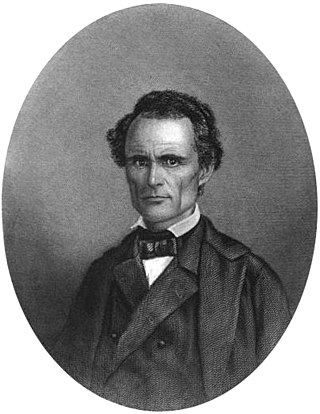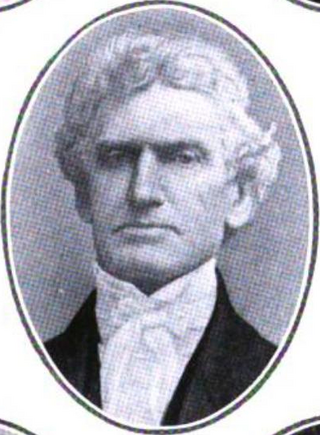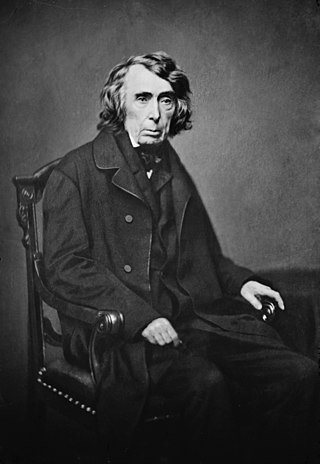Related Research Articles

Nathan Bedford Forrest was a Confederate Army general during the American Civil War and the first Grand Wizard of the Ku Klux Klan from 1867 to 1869. Before the war, Forrest amassed substantial wealth as a cotton plantation owner, horse and cattle trader, real estate broker, and slave trader. In June 1861, he enlisted in the Confederate Army and became one of the few soldiers during the war to enlist as a private and be promoted to general without any prior military training. An expert cavalry leader, Forrest was given command of a corps and established new doctrines for mobile forces, earning the nickname "The Wizard of the Saddle". He used his cavalry troops as mounted infantry and often deployed artillery as the lead in battle, thus helping to "revolutionize cavalry tactics", although the Confederate high command is seen by some commentators to have underappreciated his talents. While scholars generally acknowledge Forrest's skills and acumen as a cavalry leader and military strategist, he is a controversial figure in U.S. history for his role in the massacre of several hundred U.S. Army soldiers at Fort Pillow, a majority of them black, coupled with his role following the war as a leader of the Klan.
Dred Scott v. Sandford, 60 U.S. 393 (1857), was a landmark decision of the United States Supreme Court that held the U.S. Constitution did not extend American citizenship to people of black African descent, and thus they could not enjoy the rights and privileges the Constitution conferred upon American citizens. The decision is widely considered the worst in the Supreme Court's history, being widely denounced for its overt racism, perceived judicial activism, poor legal reasoning, and crucial role in the start of the American Civil War four years later. Legal scholar Bernard Schwartz said that it "stands first in any list of the worst Supreme Court decisions". Chief Justice Charles Evans Hughes called it the Court's "greatest self-inflicted wound".

Philip Pendleton Barbour was the tenth speaker of the United States House of Representatives and an associate justice of the Supreme Court of the United States. He is the only individual to serve in both positions. He was also a slave owner.

Noah Haynes Swayne was an American jurist and politician. He was the first Republican appointed as a justice to the United States Supreme Court.

John Archibald Campbell was an American jurist. He was a successful lawyer in Georgia and Alabama, where he served in the state legislature. Appointed by Franklin Pierce to the United States Supreme Court in 1853, he resigned at the beginning of the American Civil War, traveled south and became an official of the Confederate States of America. After serving six months in a military prison at war's end, he secured a pardon and resumed his law practice in New Orleans, where he also opposed Reconstruction.

Henry Baldwin was an Associate Justice of the Supreme Court of the United States from January 6, 1830, to April 21, 1844.

Shelby Dade Foote Jr. was an American writer, historian and journalist. Although he primarily viewed himself as a novelist, he is now best known for his authorship of The Civil War: A Narrative, a three-volume history of the American Civil War.

West Hughes Humphreys was the 3rd Attorney General of Tennessee and a United States district judge of the United States District Court for the Eastern District of Tennessee, the United States District Court for the Middle District of Tennessee, and the United States District Court for the Western District of Tennessee.

The Supreme Court of Georgia is the highest judicial authority of the U.S. state of Georgia. The court was established in 1845 as a three-member panel. Since 1896, the justices have been elected by the people of the state. The justices are currently elected in statewide non-partisan elections for six-year terms, with any vacancies filled through an appointment by the Governor.

Thomas Ruffin (1787–1870) was an American jurist and justice of the North Carolina Supreme Court from 1829 to 1852 and again from 1858 to 1859. He was chief justice of that Court from 1833 to 1852.
Parry Wayne Humphreys was an American attorney, judge, and politician who represented Tennessee in the United States House of Representatives. After serving one term in the House, he later served eighteen years as a judge on the state judicial circuit. About 1836 Humphreys moved to Hernando, Mississippi, where he worked in banking for the remainder of his life.

The Taney Court refers to the Supreme Court of the United States from 1836 to 1864, when Roger Taney served as the fifth Chief Justice of the United States. Taney succeeded John Marshall as Chief Justice after Marshall's death in 1835. Taney served as Chief Justice until his death in 1864, at which point Salmon P. Chase took office. Taney had been an important member of Andrew Jackson's administration, an advocate of Jacksonian democracy, and had played a major role in the Bank War, during which Taney wrote a memo questioning the Supreme Court's power of judicial review. However, the Taney Court did not strongly break from the decisions and precedents of the Marshall Court, as it continued to uphold a strong federal government with an independent judiciary. Most of the Taney Court's holdings are overshadowed by the decision in Dred Scott v. Sandford, in which the court ruled that African-Americans could not be citizens. However, the Taney Court's decisions regarding economic issues and separation of powers set important precedents, and the Taney Court has been lauded for its ability to adapt regulatory law to a country undergoing remarkable technological and economic progress.

John Catron was an American jurist who served as an Associate Justice of the Supreme Court of the United States from 1837 to 1865, during the Taney Court.

Peter Vivian Daniel was an American jurist who served as an associate justice of the Supreme Court of the United States.

Robert Cooper Grier was an American jurist who served on the Supreme Court of the United States.

Samuel Nelson was an American attorney and appointed as judge of New York State courts. He was appointed as a Justice of the Supreme Court of the United States, serving from 1845 to 1872. He concurred on the 1857 Dred Scott decision, although for reasons different from Chief Justice Taney's.

Roger Brooke Taney was an American lawyer and politician who served as the fifth chief justice of the United States, holding that office from 1836 until his death in 1864. Taney infamously delivered the majority opinion in Dred Scott v. Sandford (1857), ruling that African Americans could not be considered U.S. citizens and that Congress could not prohibit slavery in the U.S. territories. Prior to joining the U.S. Supreme Court, Taney served as the U.S. attorney general and U.S. secretary of the treasury under President Andrew Jackson. He was the first Catholic to serve on the Supreme Court.

The Nathan Bedford Forrest Bust is a bust of Confederate States of America Lt. General and first-era Ku Klux Klan Grand Wizard Nathan Bedford Forrest that was prominently displayed in the Tennessee State Capitol in Nashville. On July 23, 2021, the bust was removed, and was relocated to the Tennessee State Museum in a new exhibit that opened four days later.

Bolton, Dickens & Co. was a slave-trading business of the antebellum United States, headquartered in Memphis, Tennessee. Several of principals of the firm eventually shot and killed one another as part of a long-running dispute over money. A Bolton & Dickens account ledger survived the American Civil War and is a valuable primary source on the interstate slave trade.

Byrd Hill was a slave trader of Tennessee and Mississippi prior to the American Civil War. Byrd Hill has been described as one of the "big four" slave traders in the centrally located city of Memphis on the Mississippi River. Hill was partners for a time with Nathan Bedford Forrest and is believed to have resold six of the Africans illegally trafficked to the United States on the Wanderer in 1859. Hill also made a fleeting appearance in Harriet Beecher Stowe's A Key to Uncle Tom's Cabin.
References
- 1 2 "Tim Huebner". Rhodes College. Retrieved 2023-08-23.
- 1 2 "Rhodes honors Tim Huebner; History professor lauded for service". The Commercial Appeal. August 31, 2006. p. 16. Retrieved 2023-08-04.
- ↑ Goudsouzian, Aram (June 13, 2016). "Rights and Revolutions". chapter16.org. Tennessee Humanities. Retrieved 2023-07-19.
- ↑ "Recalling truths in Plessy dissent". The Commercial Appeal. May 17, 1996. p. 17. Retrieved 2023-07-19.
- ↑ "History is guide on judicial elections". The Commercial Appeal. July 5, 1998. p. 19. Retrieved 2023-07-19.
- ↑ "Parks disputes misses dual points of history". The Commercial Appeal. March 3, 2013. p. 33. Retrieved 2023-07-19.
- ↑ Huebner, Timothy S. (February 16, 2016). "In Election Years, a History of Confirming Court Nominees". Opinion. The New York Times. ISSN 0362-4331 . Retrieved 2023-07-19.
- ↑ "Tim Huebner | C-SPAN.org". www.c-span.org. Archived from the original on 2021-10-31. Retrieved 2021-10-31.
- ↑ "Rhodes History Teacher Gives Students Lessons to Remember". The Commercial Appeal. March 7, 2005. pp. B1. Archived from the original on 2023-07-14. Retrieved 2023-07-14. & "Teacher (Part 2 of 2)". p. B6. Archived from the original on 2023-07-14. Retrieved 2023-07-14.
- ↑ "Three Rhodes College faculty". The Commercial Appeal. December 15, 2019. pp. C1. Retrieved 2023-08-04.
- ↑ "Tim Huebner | Rhodes College". Archived from the original on 2021-10-31. Retrieved 2021-10-31.
- ↑ "Three Rhodes College faculty". The Commercial Appeal. December 15, 2019. pp. C1. Retrieved 2023-08-04.
- ↑ "Lincoln and the Constitution: Presentation by Dr. Timothy S. Huebner". Audio. August 9, 2021. Archived from the original on 2021-09-25. Retrieved 2022-05-01.
- ↑ "Rhodes prof speaks at Supreme Court". The Commercial Appeal. October 16, 2014. p. 16. Retrieved 2023-07-19.
- ↑ Huebner, Timothy S. (December 27, 2017). "Confronting the true history of Forrest the slave trader". Opinion. The Knoxville News-Sentinel. pp. 15A. Retrieved 2023-07-19.
- ↑ "Nathan Bedford Forrest historical marker apparently vandalized". The Commercial Appeal. July 20, 2020. pp. A5. Retrieved 2023-08-04.
- ↑ "Letters to the Editor: Aware of history". The Tennessean. January 9, 2019. pp. A17. Retrieved 2023-08-04.
- ↑ Wiecek, William (July 14, 2017). "Review of: Timothy S. Huebner, Liberty and Union: The Civil War Era and American Constitutionalism". Journal of Supreme Court History. 42: 118. Retrieved 2023-07-14.